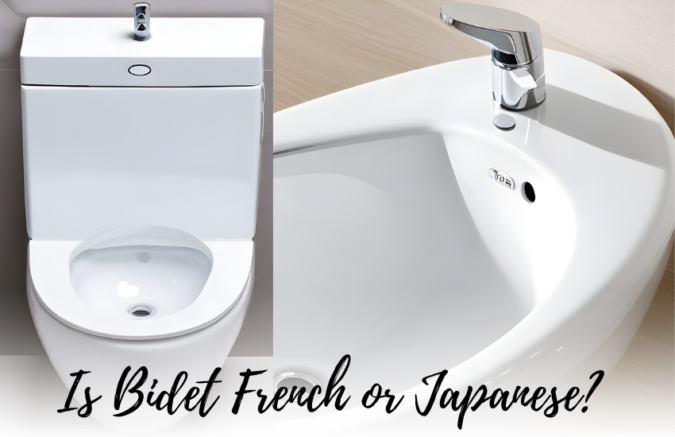Introduction:
A bidet is a bathroom fixture designed for personal hygiene, typically used after using the toilet. Its washbasin sprays the water allowing individuals to clean themselves after using the toilet. Is Bidet French or Japanese?
It comes in various forms, from standalone fixtures to integrated units within toilets and they offer an alternative means to maintain cleanliness compared to using toilet paper.
Where did Bidets Originate from?
The earliest documented use of a personal cleansing device dates back to the late 17th century in France. The word “bidet” itself is French, translating to “pony” in English. Initially, it referred to a separate porcelain bowl or container filled with water, primarily used by French nobility for personal hygiene. The French association with its name and early design cemented its initial ties to European culture.
French aristocracy popularized the bidet, primarily as a means of personal hygiene, particularly for women’s use after childbirth. Its functionality expanded over time, becoming a fixture in many French bathrooms, solidifying its association with French culture.
What is the role of Japanese Culture in bidet evolution?
While the term “bidet” is French, Japan’s contribution to its evolution cannot be overlooked. In Japan, the concept of using water for personal hygiene has ancient origins, and the innovation of the “washlet” in the 1980s revolutionized bathroom hygiene practices.
The washlet, developed in the mid-20th century, revolutionized bathroom experiences with its incorporation of water jets, temperature controls, and even air drying features. This technological marvel gained immense popularity in Japan and eventually made its way across the globe.
Is the modern bidet more influenced by French or Japanese design?
Cultural Fusion:
The modern version is a fusion of French elegance and Japanese innovation. Combining elements from both cultures, it has evolved into various forms, including attachments for existing Bidet toilet. This evolution showcases the melding of French historical significance with Japan’s technological advancements.
Global Adoption:
In recent decades, bidet attachments have surged in global popularity, offering a space-saving and cost-effective alternative to standalone ones. Its widespread adoption reflects a harmonious amalgamation of French sophistication and Japanese technology, transcending cultural boundaries.
Cultural Perceptions and Practices:
France’s Bidet Culture:
- Remains a prevalent fixture in French Households.
- Reflects deep historical roots and cultural significance.
- Historically favored, notably for post-childbirth hygiene.
- Symbolizes French refinement and cultural elegance in personal hygiene practices.
Bidet Presence in Other Regions:
- Less common in numerous global areas.
- Toilet paper holds dominance as the primary personal hygiene method.
- Diverse cultural perspectives influence bidet adoption rates
- Some cultures view them as unnecessary or less accessible due to differing hygiene customs.
Japan’s Embrace of Washlet Technology:
- Extends washlet technology beyond Japanese homes.
- Utilization in public restrooms, hotels, and even airports.
- Reflects Japan’s cultural focus on:
- Upholding cleanliness as a societal norm.
- Prioritizing comfort and technological advancements in daily life.
- Integrating advanced technology seamlessly into everyday experiences.
- Washlets epitomize Japan’s innovative, hygiene-oriented, and comfort-driven standards.
Conclusion:
The bidet’s lineage is an intertwined tapestry of French elegance and Japanese innovation. Its journey from a French aristocratic amenity to a global bathroom staple highlights the amalgamation of cultural influences and technological advancements.
While its origins might spark debates, its universal appeal lies in its commitment to personal hygiene, comfort, and sustainability. As societies evolve and prioritize eco-friendly practices, the bidet stands as a testament to cultural exchange and adaptation, blending the sophistication of French design with the technological prowess of Japan.
In essence, whether you view the bidet as inherently French or distinctly Japanese, its presence in bathrooms worldwide symbolizes a harmonious blend of diverse cultural legacies, enriching the way we approach personal hygiene and well-being.
FAQs:
The modern bidet represents a fusion of French elegance and Japanese innovation. While its historical roots are tied to France, technological advancements and features, particularly in washlets, showcase significant Japanese influence.
Bidet prevalence varies globally. While France retains a strong bidet culture, bidets are less common in many regions, where toilet paper remains the primary hygiene method. Japan, however, widely embraces washlet technology, even in public spaces like restrooms and hotels.
While the term “bidet” originates from France, Japan played a pivotal role in the bidet’s technological advancement. Japan’s innovation in bathroom hygiene practices, especially the introduction of the “washlet” in the mid-20th century, revolutionized bidet technology.
